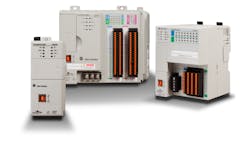Use of embedded devices has been core to automation since the advent of its modern forms. But more recent advances in embedded technologies, initially developed for consumer use, are starting to have a big impact on the automation technologies now being introduced.
As I gathered information for my February 2013 feature on the topic of embedded trends in automation, I came across several instances of suppliers that are already rolling out cutting-edge embedded technology in their products.
For example, Beckhoff is equipping all of its industrial and panel PCs with the new “Sandy Bridge” Intel processors. These new Intel processors are also making inroads into the company’s embedded PCs in the new CX2000 series, which brings multi-core processor technology to the DIN rail-mounted format.
“The real world implications of today’s multi-core processor technology are many,” says Graham Harris, president, Beckhoff Automation. “In response to this, Beckhoff has coined the phrase ‘Scientific Automation’ to describe the convergence of lab and measurement technologies with the standard automation controller.”
Harris says that more engineers are now thinking in terms of software layers rather than hardware modules. “This approach is far more cost-effective and offers a much faster time to market for new machine technologies,” he says.
Beckhoff’s new TwinCAT 3 platform is an example of a product in line with the company’s view of ‘Scientific Automation’ because it can act as the catalyst to integrate previously separate technologies into the primary automation controller. According to Harris, these technologies include, but are not limited to, measurement, condition monitoring, and robotics.
“Today it is possible to implement all of these critical machine systems using a single software environment, which will spread significant efficiencies and savings across the entire enterprise,” says Harris. “When machine builders and manufacturers can actively eliminate separate hardware controllers and different software platforms, the resulting competitive advantage is immediate and considerable.”
B&R Automation is moving in a similar direction with embedded tech. Robert Muehlfellner, director of automation technologies at B&R, says that the company is focusing on PC-style architectures because automation control, whether it’s housed in a PC, panel device or brick-style controller, is very similar to embedded PC architectures. “This means we can combine all the automation functions—such as sequential logic control, I/O handling, and visualization—in a single processor,” he says.
As with most new industrial technology introductions, the rise of embedded in automation is largely being driven by customer demands.
“The OEMs want their machines to do more, but they don't want the complexity of spreading it over multiple processors,” says Muehlfellner. “Embedded Intel architectures enable us to integrate capabilities that used to require a separate PC connected to controller. We can now eliminate that additional PC running Windows because we can integrate functionalities like Web servers right on the control device.”
Lee Lane, director of business development for control and visualization at Rockwell Automation, adds that with customer demands driving the increased use of embedded in all types of automation devices, the amount of information coming back to the controllers has increased dramatically.
“It used to just be a 4-20mA signal coming back to the controller,” says Lane, “but now it’s a constant stream of information that requires controllers to be set up to handle that information. These changes can be seen in our 5370 and L7X controllers. As an example of how we’re supporting this increase in data, we’ve moved from using serial ports to USB ports.”
Leaders relevant to this article:


